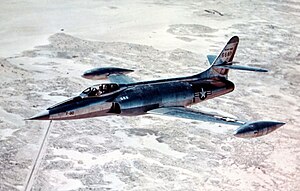XF-90
| XF-90 | |
|---|---|
 |
|
| XF-90 in flight | |
| Role | Fighter |
| Manufacturer | Lockheed |
| First flight | 3 June 1949 |
| Status | Canceled |
| Number built | 2 |
| Unit cost |
US$5.1 million for the program
|
The Lockheed XF-90 was built in response to a United States Air Force requirement for a long-range penetration fighter and bomber escort. The same requirement produced the McDonnell XF-88 Voodoo. Lockheed received a contract for two prototype XP-90s (redesignated XF-90 in 1948). The design was developed by Willis Hawkins and the Skunk Works team under Kelly Johnson. Two prototypes were built (s/n 46-687 and -688). Developmental and political difficulties delayed the first flight until 3 June 1949, with Chief Test Pilot Tony LeVier at the controls. Performance of the design was considered inadequate due to being underpowered, and the XF-90 never entered production.
In response to a 1945 Army request for an advanced jet fighter, Lockheed proposed a jet powered initially by a Lockheed L-1000 axial flow turbojet, and then the General Electric J35. Further design refinements included using two Westinghouse J34 engines with afterburners. After data showed that a delta planform would not be suitable, the Lockheed Model 90 was built as a mockup in 1947 with swept wings.
The final design embodied much of the experience and shared the intake and low-wing layout of the previous P-80 Shooting Star, but with 35° sweptback wings, a sharply-pointed nose and two Westinghouse J34-WE-11 axial-flow turbojet engines, providing a total thrust of 6,200 lbf (27.6 kN), mounted side-by-side in the rear fuselage and fed by side-mounted air intakes. The wings had leading edge slats, Fowler flaps and ailerons on the trailing edge. The pressurized cockpit was fitted with an ejector seat and a bubble canopy. Proposed armament was six 20 mm (.79 in) cannons. The internal fuel was supplemented by wingtip-mounted tanks, bringing total fuel capacity to 1,665 gal (6,308 l). The use of 75ST aluminum rather than the then-standard 24ST aluminum alloy, along with heavy forgings and machined parts, resulted in an extremely well-constructed and sturdy airframe. However, these innovations also resulted in an aircraft with an empty weight more than 50 percent heavier than its competitors.
...
Wikipedia
